Adenoiditis in children - photos, symptoms and treatment recommendations Adenoiditis is a disease that is characterized by inflammation of the pharyngeal tonsils of a chronic or acute type.
Since anatomically, the tonsils are located in the pharynx, they are practically invisible during a normal throat examination, so the inflammatory process can go unnoticed for a long time.
According to Komarovsky, in 80% of cases, adenoiditis occurs in children, since in adulthood the pharyngeal tonsils atrophy and no inflammatory processes occur.
Causes
What it is? Adenoids (otherwise, adenoid growths or vegetations) are commonly called hypertrophied nasopharyngeal tonsils. Their growth occurs gradually.
The most common cause of this phenomenon is frequent diseases of the upper respiratory tract (rhinitis, sinusitis, pharyngitis, laryngitis, tonsillitis, sinusitis and others). Each contact of the body with infection occurs with the active participation of the pharyngeal tonsil, which at the same time increases slightly in size. After recovery, when the inflammation passes, it returns to its original state.
If during this period (2-3 weeks) the child falls ill again, then, not having time to return to its original size, the amygdala enlarges again, but larger. This leads to constant inflammation and growth of lymphoid tissue. [adsense1]
What are adenoids?
Adenoids are not an organ, as many are accustomed to believe; this is the name given to pathological growth of the pharyngeal tonsil without signs of inflammation.
Often, adenoids are a concomitant symptom of some other disease, but in some cases they can develop into a separate chronic problem that prevents the child from breathing and living normally. As a rule, they appear in children under ten years of age, and with age the size of the pharyngeal tonsil decreases. In adults, it sometimes disappears completely. For children, this is an indispensable organ, since until the age of five, a child encounters a gigantic amount of bacteria, viruses and microbes - this is how his immunity is formed.
Degrees of the disease
If a mild form is not detected and measures are not taken, adenoiditis transitions to an acute form, which is divided into several stages of enlargement of the pharyngeal tonsils:
- First degree. The adenoids enlarge and cover the upper part of the bony nasal septum
- Second degree. The size of the tonsils covers two thirds of the bony nasal septum
- Third degree. Almost the entire nasal septum is covered by adenoids.
The acute form requires immediate treatment, as in the future it can develop into chronic adenoiditis, which negatively affects the child’s health. Enlarged tonsils become inflamed and a large number of bacteria develop in them.
Forms of the disease
Acute adenoiditis is an independent form of the disease. In general, all pathologies of the nasopharyngeal tonsil are divided into several types:
- adenoids - enlargement of the nasopharyngeal tonsil, disrupting normal breathing through the nose;
- subacute adenoiditis - inflammation of the hypertrophied tonsil, occurring in a subacute form;
- acute adenoiditis - most often purulent inflammation of the nasopharyngeal tonsil;
- chronic adenoiditis is a sluggish inflammatory process with a chronic focus of infection in the nasopharynx.
Adenoids themselves are not an inflammatory disease, but are considered a major factor that increases the risk of developing adenoiditis. Depending on the severity of hypertrophy, adenoids of 1st, 2nd and 3rd degrees are distinguished. Grade 1 is the mildest, characterized by slight enlargement of the tonsil, which may be accompanied by nasal sounds and snoring. Starting from the 2nd degree, there is a violation of normal breathing through the nose, as a result the child breathes through the mouth, which entails a decrease in local immunity.
Note! It is grade 2 and 3 adenoids that are the main risk factor for the development of adenoiditis.
Subacute adenoiditis is characterized by moderate symptoms that increase rather slowly. Symptoms of moderate severity can persist for a long time, up to a month. The problem with the subacute form of inflammation is that parents often make the wrong diagnosis on their own when starting to treat their child for a cold, which ultimately leads to the inflammation becoming chronic.
Acute adenoiditis is characterized by specific symptoms that every parent should know. It is necessary to dwell in more detail on the features of the manifestation of this disease.
Symptoms of adenoiditis in children
The manifestation of adenoiditis in children can cause a number of complications, so it is very important to detect and treat it in the initial stage, and here knowledge of the symptoms will help us. Depending on the stage and nature of the disease, its manifestations may vary significantly.
So, the signs of acute adenoiditis in a child are as follows:
- runny nose and coughing attacks;
- when examining the throat, slight redness of the upper tissues is observed;
- mucopurulent discharge from the nasopharynx;
- heat;
- pain when swallowing;
- feeling of nasal congestion;
- headache;
- general fatigue and loss of strength
Chronic adenoiditis develops as a result of acute inflammation of the adenoids. Its symptoms:
- runny nose (sometimes with purulent discharge);
- changes in voice and speech sound;
- frequent colds and sore throats; nasal congestion;
- recurrent otitis media (ear inflammation) or hearing loss;
- the child is lethargic, does not sleep well and always breathes through his mouth.
The child often suffers from viral infections. This is due to both decreased immunity and constant secretion of infected mucus during adenoiditis in children. Mucus flows down the back wall of the pharynx, and the inflammatory process spreads to the lower parts of the respiratory tract.
Chronic hypoxia and constant stress on the immune system lead to delayed physical and mental development. Oxygen deficiency is manifested not only by general hypoxemia, but also by underdevelopment of the facial skull, in particular the upper jaw, as a result of which the child develops an abnormal bite. Deformation of the palate (“Gothic” palate) and the development of a “chicken” chest are possible. Adenoiditis in children also leads to chronic anemia. [adsense2]
Difference between adenoids and polyps
Polyps are abnormal, benign growths. They occur in the paranasal sinuses or nasal cavity due to frequent inflammation of the nasopharynx, not allowing air to circulate freely and leading to the development of inflammatory processes. When they grow, chronic sinusitis often develops. They differ from adenoids in that they are foreign growths, while tonsils are an integral part of any organism, which grows greatly under the influence of various factors.
It is possible to determine what is preventing the child from breathing normally - polyps or adenoids - using computed tomography and endoscopy of the nasal cavity. In the first case, they determine how much the lymphoid tissue has become inflamed and overgrown. Adenoid endoscopy in children reveals what is happening to the tonsils.
Diagnostics
Diagnosis of adenoids does not require the use of specific methods and studies. Based on a visual examination, the ENT doctor makes a preliminary diagnosis and, if necessary, uses additional diagnostic methods.
Namely:
| Posterior rhinoscopy. | Examination of the tonsil with a mirror. It is very difficult for children to carry out this method, since touching the mirror to the mucous membrane often causes a gag reflex. |
| Finger examination. | A diagnostic method performed by a doctor to determine the extent of enlargement of the adenoids. |
| X-ray of the nasopharynx. | Allows you to determine the degree of growth of the adenoids and exclude sinus diseases. |
| Endoscopic method | Examination of the tonsil using an endoscope. The most informative method of all listed allows you to determine not only the size of the tonsil, but also its condition, and at the same time identifies concomitant diseases in the nasopharynx. Displays the image on the monitor. |
Why do adenoids enlarge?
Enlargement of the nasopharyngeal tonsil and proliferation of lymphoid tissue are quite typical for colds, and especially viral diseases. A child with ARVI cannot breathe through his nose, but this usually lasts no more than a week. In what other cases is there an enlargement of adenoids and why the tissues do not shrink for a long time, let’s try to figure it out.
- Frequent colds.
If a child is constantly forced to come into contact with infected people, he often gets sick, this is especially pronounced if the immune system is weak. In this case, the tonsils simply do not have time to return to normal; they are constantly swollen. A similar condition is often observed in weak children who go to kindergarten. - Infection.
Many infectious diseases, among other symptoms, have exactly this manifestation - enlarged adenoids. If the child suddenly stops breathing through his nose, but there is no discharge from the nose, you need to examine the baby for a rash and monitor the temperature. Adenoids can be enlarged with scarlet fever, influenza, measles, mononucleosis, diphtheria, rubella, whooping cough, etc. - Allergy.
The constant presence of the tonsil in an enlarged and inflamed state may indicate regular contact with the allergen. That is, adenoids are a response to irritation of the mucous membrane. An allergen can be anything - food, plant pollen, dust, animal hair, etc. - Reduced immunity.
If a child is weak, does not walk in the fresh air, does not have a healthy and nutritious diet, if he constantly suffers from chronic and infectious diseases, his immunity is very weak. The body's defenses are also reduced if the child breathes dry and hot air, if he lives in a poor environmental environment, if he is surrounded by dust. Frequent consumption of sweets, preservatives and artificial colors, flavors, and overeating have a very detrimental effect on the condition of the body. - Complications.
Often, a child’s tendency to develop adenoids is a consequence of various problems the mother has during pregnancy. This is taking antibiotics, fetal trauma, intrauterine hypoxia, taking strong medications, drugs or alcohol, especially in the early stages of pregnancy. - Heredity.
Sometimes the structure of lymphoid tissue and its predisposition to increase is genetic. Namely, a pathology called lymphatism. This leads to a deterioration in the normal functioning of the thyroid gland - the child becomes lethargic, apathetic, and easily gains weight. - Breast-feeding.
It has long been proven that a child fed with breast milk for at least six months has a much stronger immune system; antibodies to various pathogens have been formed in the body.
All these reasons can trigger the occurrence of adenoiditis in children. But how does it manifest itself? How to recognize the disease in time and begin adequate treatment?
how to treat adenoids in a child at home
How to treat adenoiditis in children?
Without surgery, you can get rid of grade 1–2 adenoiditis. In this case, it is necessary to follow an integrated approach, combining general treatment and local effects on vegetation. Below is an approximate treatment plan.
General treatment is as follows:
- immunomodulators (Immunal, Echinacea tincture);
- immunostimulants for a course of 10–15 days (FIBS, Aloe extract, Apilak);
- vitamins and microelements;
- antihistamines for a course of 7–14 days (Fenkarol, Suprastin, Diazolin, Pipolfen);
- for acute purulent adenoiditis, antibiotics and sulfonamides are indicated.
Local treatment offers the following options:
- drops with an anti-inflammatory effect for adenoiditis - Protargol, Nasonex;
- nasal rinsing - used both for adenoids and for their inflammation; for rinsing, you can use solutions of sea salt, Elekasol, Miramistin, Rotokan, Furacilin;
- nasal drops with a vasoconstrictor effect - reduce tissue swelling, relieve a runny nose, and facilitate the subsequent procedure of rinsing the nose; you can drip your nose with Tizin, Vibrocil, Sanorin;
- introduction into the nasal cavity of drugs in the form of drops, spray or solution applied to the turunda - Bioparox, Protargol, Collargol, Albucid, Sofradex, Avamis;
- inhalation through a nebulizer - Cedovix, Mentoclar.
It is worth noting that as the child ages, the adenoids can decrease in size on their own. This is due to the fact that from adolescence the overall incidence of respiratory infections decreases significantly. The nasopharyngeal tonsil ceases to be in constant contact with pathogenic microorganisms and begins to regress (decrease in size). [adsense3]
Treatment of acute adenoiditis
In the treatment of acute adenoiditis, a conservative approach is practiced. The patient is prescribed a number of medications to relieve acute symptoms, as well as maintenance therapy to strengthen the immune system.
Surgical treatment of adenoiditis is not practiced, since the source of infection must first be eliminated. Surgery can be recommended only if inflammation has developed against the background of grade 3 adenoids, and conservative therapy is ineffective.
Rinse the nose and relieve swelling
The spray effectively relieves symptoms of nasal congestion
Acute adenoiditis in children always begins with severe nasal congestion, so treatment is aimed at relieving these symptoms and restoring normal breathing through the nose.
Note! If the adenoids are inflamed, the child should not continue to breathe through the mouth, as this only intensifies the symptoms and can cause the development of a chronic form of the disease.
It is best to treat acute adenoiditis by rinsing the nose, professionally rather than at home. To do this, you need to consult with an otolaryngologist about the possibility of performing a “cuckoo test”. This method allows you to effectively clear the nasal sinuses of mucus and normalize breathing.
It is recommended to undergo several professional rinsing sessions and then continue the treatment at home. At home, the nose is treated:
- sea water spray (Aquamaris, Humer);
- saline solution (1 tsp per 200 ml of water);
- Furacilin (1 tablet per 200 ml of water).
Nasal irrigation is carried out using a syringe without a needle or an Esmarch mug. Your doctor will give you detailed recommendations for home rinsing.
Additionally, it is necessary to eliminate swelling of the nasopharynx. For this purpose the following is prescribed:
- antihistamine tablets (Loratadine, Suprastin)
- nasal drops for allergies (Zodak, Fenistil);
- hormonal drugs for the common cold (Nasonex and analogues).
Additionally, it is necessary to use vasoconstrictor drops (Noxprey Baby and analogues), but they should not be abused. Doctors prescribe such medications for children to drip only before bed to ensure normal breathing through the nose during sleep.
Antibiotics and other drugs
In acute adenoiditis in children, symptoms can be relieved by nasal rinsing alone, but effective treatment requires antibiotics. How to treat acute adenoiditis depends on the causative agent of the disease and the age of the child. Antibiotics may only be used as prescribed by a doctor. The most commonly prescribed drugs are Sumamed, Augmentin, Amoxiclav, etc. The dosage and regimen are selected individually for each child.
For sinusitis, nasal drops with an antibiotic, for example, Isofra, can be used. However, it all depends on the age of the child and the general treatment regimen. If the doctor has prescribed antibiotics in tablets, it is not always advisable to use nasal drops with an antibacterial composition.
In cases where adenoiditis has caused complications in the form of otitis media, antibacterial ear drops are prescribed. The most popular drugs are Sofradex, Normax, Norfloxacin. These agents provide a rapid local antibacterial effect, eliminating the symptoms of otitis media in 1-2 days.
Symptomatic therapy is also prescribed, for example, antipyretic drugs for children, such as Nurofen and Panadol. It is advisable to take them only when the temperature rises above 38.5 degrees.
Immune support and recovery
You can do from two to four injections during the day
In addition to nasal drops and antibiotic tablets, the pediatrician will definitely prescribe restorative therapy for acute adenoiditis in a child. It consists of receiving:
- immunostimulants;
- homeopathy;
- vitamins
Immunostimulants are used to prevent complications and speed recovery. The most popular drugs for children are Lavomax and Interferon. The doctor may also prescribe local immunomodulators - IRS-19 nasal drops or homeopathic Euphorbium Compositum nasal spray.
Folk remedies used include echinacea tincture and extract, and propolis.
For sinusitis and otitis media, homeopathic remedies with anti-edematous and anti-inflammatory effects are indicated. Children are prescribed the drugs Sinupret and Cinnabsin.
You can supplement therapy at home with various restorative drops, for example, Sialro or Derinat, as well as vitamin preparations. For a quick recovery and reducing the risk of complications, it is recommended not to self-medicate, but to trust an otolaryngologist.
Adenoid removal
Surgical treatment of adenoiditis in children is carried out when conservative methods are ineffective, as well as when nasal breathing is difficult. The decision about whether to remove the adenoids rests with the parents. But there are a number of absolute indications for surgery. In these cases, intervention cannot be avoided.
Absolute:
- inability to breathe through the nose (adenoids grade 2 - 3);
- deformation of the sternum and face;
- large adenoids;
- hearing loss.
Relative:
- persistent rhinitis;
- chronic adenoiditis;
- bad breath;
- snoring, poor sleep;
- frequent otitis and sinusitis, ARVI.
Indications for surgery:
- Severe nasal breathing disturbances;
- Beginning deformation of the facial skeleton and chest;
- Hearing impairment caused by hypertrophy of the nasopharyngeal tonsil;
- Existing chronic inflammatory diseases of other organs of the upper respiratory tract.
Laser removal of adenoids has a number of advantages over the traditional method:
- The recovery period after surgery is reduced.
- Minimal blood loss.
- The surgeon's actions are more precise.
- The area of the injured area is reduced.
- Complete sterility and reduced risk of complications.
Laser removal of adenoids in children can be used in two ways:
- Coagulation. A focused beam is used. Recommended for removing large formations.
- Valorization. The upper layers of the adenoids are burned with steam using a carbon dioxide laser. Recommended for early stages and small-sized lesions.
Video: indications for removal of adenoids in a child - Dr. Komarovsky.
Symptoms and signs of adenoids
The main symptoms of adenoids include:
- frequent runny nose that does not go away for a long time and is difficult to treat;
- restless sleep;
- inhales with your mouth open;
- constant mucus discharge from the nose, causing irritation of the skin on the upper lip and around the nose;
- difficulty breathing through the nose, even if there is no runny nose;
- apathy, lethargy;
- the voice loses sonority and becomes hoarse;
- involuntary movements: blinking and nervous tics;
- dry cough in the morning;
- attacks of suffocation at night, which are typical for grade 2-3 adenoids;
- hearing loss;
- headache.
Many parents are interested in how to understand that their child has adenoids. With this disease the following is observed:
- the bridge of the nose becomes wider;
- chin recedes;
- the upper lip is made shorter;
- the face lengthens;
- the mouth is constantly open;
- the head moves forward.
Against the background of adenoids in the nose, a complication such as adenoiditis often occurs, occurring in acute or chronic form. In the acute form, the temperature rises, weakness, burning and pain in the nasopharynx, runny nose, nasal congestion, mucopurulent discharge, and enlarged lymph nodes appear.
Reviews
Good afternoon. My child was 4 years old when adenoids were discovered. For some time, I began to notice that the child’s hearing began to worsen, at first I thought that he was playing, he couldn’t hear, or he was carried away by the game, but it got worse, they went to the ENT specialist, they said that the adenoids were pressing from the inside, and therefore the hearing was disappearing. We were treated for 3 months with drops costing 1000 rubles, there was no change.
The pediatrician advised that it would be better to remove them; there was little benefit from treatment, and my hearing was getting worse. We performed the operation, stayed in the hospital for about 4-5 hours, the operation lasted 20 minutes, the rest of the time the child recovered from the anesthesia and slept. The only negative is that children do not tolerate anesthesia well, they scream, cry, and not being particularly conscious. Now a year has passed, during this time the nasal congestion does not bother me, my hearing is good, and my pain has become much less frequent. [adsen]
Signs of pathogenic adenoids in two-year-old children
The older the child, the stronger his general immune resistance of the body. The younger the baby, the much less chance there is of resisting adenoviral intoxication. The emerging signs of adenoids in a child of the 2nd year of life, the severity of adenoid vegetation depend on the state of children's homeostasis. According to morphophysiological indicators and psychosomatic parameters of development, according to two years of age.
The baby has a strong musculoskeletal structure, an excellent appetite, a cheerful and playful disposition, intelligent and without hereditary or congenital pathologies. Then adenoviral respiration will pierce its natural protective barrier for quite a long time - accumulate excessively in the nasopharyngeal glands. Methodical patho-invasion to dysfunction the nasal adenoids.
Even if, after all, his adenoid locations have undergone pathogenic destruction, the child’s body will show an intense resistance reaction. Parents should not panic or regard it as something terrible if their strong child begins:
- snot profusely (rhinorrhea);
- his temperature rises steadily upward (in 2-4 hours from 36.6 to 37.8, 38.00 on the thermometer);
- hot forehead, with signs of chills;
- tearfulness (reddened eyelids, pinkish sclera);
- the child complains of headaches (points to his head - “vava”).
Related articles Beware!
Temperature with adenoids Subsequently, complete nasal congestion and mouth breathing develop. Painful somatics are accompanied by: disorders in the gastrointestinal tract - nausea, diarrhea, intestinal flatulence (gases with a foul odor, rotten eggs). Children refuse food and constantly ask for water. The outer skin is sticky and covered with sweat.
So. Perhaps the immune and lymphatic systems are too active and aggressive (under the preventive influence of brain impulses) trying to remove the adenoid strain from the child’s body. Nasal mucus, in massive streams, washes away harmful microflora from the nasopharyngeal sectors. Infectious toxins are partially eliminated through the pores of the skin epidermis (dewy sweat). Frequent urination, loose stools, and vomiting clear the visceral organic areas (stomach, intestines, kidneys, liver) from the penetration of the pathogenic viral mass into these vital parenchymas.
To say that parents need to rejoice at such aggressively dynamic manifestations of immune defense in a child with signs of adenoiditis is absolutely not worth it. Or do nothing in terms of alleviating the baby’s painful condition (“This is good. This means the immune system is working perfectly.” Two-year-old children, even if they are in good health, still need help during periods of exacerbation of adenointoxication.
The pediatric ENT doctor prescribes appropriately selected antibiotics and nasal vasodilators. Which ones exactly? This is decided individually, in each individual anamnesis. “Nasonex”, “Viferon”, “Avamys” remain popular and in demand. Rinsing the nose with herbal homeopathic solutions - Borjomi mineral water, beet juice, a decoction of dried linden + chamomile + white acacia inflorescences with the addition of a few drops of aloe, kalanchoe, eucalyptus juice.
In cases where weakened 2-year-old children are affected by adenoid disease, the signs of painful infectious plasia do not appear as clearly as in the previously described situations. Rhinitis symptoms (runny nose) are not severe. The temperature is usually low-grade (sluggish). Nasal congestion is partially clear.
In the general context, the child’s body practically does not demonstrate active resistance. The general condition of the children worsens, the child becomes weaker and has a pale face. There is shortness of breath, rapid fatigue, children are inactive and prefer to lie down more. Although, during an endoscopic visceral examination, intensive adenoid proliferation is diagnosed.
Related articles Types of runny nose with adenoids: symptoms, description
Treatment of children with a low immune threshold of resistance, with signs of adenoids, which are considered, based on the conclusion of a medical examination, to be an extremely dangerous clinical pathology, is carried out only under strict medical supervision. Preferably in a dispensary-inpatient treatment option. Thus, for such children, it is necessary to apply intensive conservative therapy (intramuscular injections, intravenous drips, inhalation techniques).
Folk remedies
We offer you tips tested by other people:
- rinse the nose with anti-inflammatory herbs (St. John's wort, calendula, chamomile, coltsfoot);
- fresh infusion of oak bark is dripped into each nostril, 2-3 drops (1 tsp per glass of water or a bag from the pharmacy, boils for 1-2 minutes, then infuses for another 15), very well reduces the volume of tonsils - tested by me and a friend ;
- put a couple of drops of thuja oil into the nose (the drug “Thuja DN” is suitable, not ether);
- rinse the nasal passages with a propolis solution - 20 drops per 1 cup of water and a quarter teaspoon of soda, use half a glass of the composition per rinse.
It is worth noting that it is not worth fighting adenoids only with folk remedies. It is better to adhere to the regimen recommended by doctors and, with his permission, add some home recipes to it.
Treatment of adenoids in a child
The first stage of adenoiditis in most cases is cured with conservative therapy. It includes the following set of activities:
- washing;
- nutrition correction;
- immunostimulation with vitamins;
- gymnastics;
- lymphatic massage.
First of all, sweets and carbonated drinks are excluded from the diet. They provide a breeding ground for pathogenic microorganisms and inhibit the treatment of the disease. It is also necessary to stop drinking milk. The child's menu includes foods rich in vitamins and minerals. Vitamins A and C strengthen the immune system, which is necessary when fighting infection. During treatment, the child should stay at home so as not to catch another infection.
Many parents are interested in what is better - Avamis or Nasonex for adenoids. Numerous reviews of these drugs indicate that their effectiveness depends on the severity of the pathology. Nasonex is recommended for use at the initial stage of the disease, and Avamis is used in more advanced cases.
Washing for adenoiditis
This procedure is carried out in 2 ways:
- The child bends over the sink, after which 100 ml of solution is injected into each nostril. The liquid, passing through the nasopharynx, is poured into the sink. For the solution, decoctions of herbs are used - St. John's wort, chamomile. You can use salt water or soda solution for these purposes. The concentration of these components should be low so that the nasal mucosa is not overly aggressive.
- It is better to use the second method for adenoids in children. The child lies down, throws his head back, and a medicinal solution is instilled into each nostril with a pipette. Since the adenoids are located on the back wall, the solution directly affects the pathological area.
For adenoids, rinsing is carried out 4-5 times a day. Conservative treatment of enlarged tonsils is considered a reliable method because the causes of the disease are eliminated and the body is stimulated to fight the disease.
Massage for adenoiditis
Since the adenoids are connected to the lymphatic system, lymphatic massage helps a lot. With its help, metabolism in cells and tissues is accelerated, blood circulation is increased, and toxins are quickly eliminated. It should be done with smooth movements in the direction of lymph flow: from the toes to the hip joint, from the wrists to the neck and shoulders. Separately, massage the abdomen. The duration of the procedure is 30-40 minutes.
You can use diluted essential oils. For adenoid hypertrophy in children, it is allowed to place 2-3 drops in the room for disinfection. After the massage, you should drink freshly squeezed juice or still water.
For enlarged tonsils, it is recommended to perform acupressure with gentle movements from the nose to the temples and cheeks, between the eyebrows, in the area of the wings of the nose. In addition, there are biological points at the back along the neck and on the back of the head.
Treatment of adenoids with folk remedies
Traditional medicine is represented by various means that help strengthen the immune system and cure adenoids:
- honey and other bee products;
- vitamin therapy with fruit and vegetable juices;
- use of spices;
- medicinal herbs;
- diet.
But before treating a child with these methods, you must consult a doctor. Propolis is allowed from beekeeping products, from which a tincture is made, and the resulting solution is instilled into the nose. This product has a local bactericidal effect. If the tonsils become inflamed and enlarged, then honey should be consumed orally with water.
Decoctions of string, coltsfoot, St. John's wort, eucalyptus and chamomile are used for inhalation. You can mix several herbs, brew and drink as tea. Licorice root is taken in the same way because it stimulates the lymphatic system.
The use of spices helps food to be better absorbed and cleanse the body of toxins and poisons. The menu should include:
- mustard;
- black pepper;
- cloves;
- ginger;
- turmeric;
- basil;
- fennel;
- garlic.
Carrots and beets are beneficial. They are baked, boiled, and made into salads. In addition, squeeze out the juice, mix and drink 2-3 tbsp on an empty stomach. l.
The child’s diet includes fish, meat, green vegetables: cabbage, peas, broccoli.
It is extremely useful for such a disease to eat oat bran bread with an egg. To prepare it, mix 2 raw eggs and 4 tbsp. l. bran, add spices and salt. The mass is placed in a frying pan and fried without oil. When one side is browned, turn it over.
Gymnastics for adenoids in a child
With adenoids, it is allowed to perform physical exercises that stimulate lymphatic drainage and blood circulation. The child needs to do gymnastics in the morning and evening. He should do squats, which will work the arm curls and popliteal lymph nodes well.
It is recommended to perform breathing exercises:
- one nostril is pinched with a finger, and the other is necessary to breathe; then - vice versa;
- breathe with the stomach;
- hold their breath for a short period of time.
This procedure should last no longer than 15 minutes.
Magnet for adenoiditis in a child
Magnets have a beneficial effect on the adenoids. They should be placed near the lymph nodes: in the groin, on the neck. They have an anti-edematous and bactericidal effect, as they are able to increase blood circulation and remove toxic substances from the body.
Shilajit is a general tonic for children
For adenoids, you can use mumiyo. This product contains a large number of useful components. It must be dissolved in an amount of 1 g in 1 liter of boiled water and left for 24 hours. Take the product in equal parts throughout the next day. The resulting solution can be stored for no more than a day.
Prevention and prognosis
It boils down to this:
- Timely treatment of colds and respiratory infections;
- Balanced diet;
- Taking vitamins and local immunomodulators in the winter;
- Nasal hygiene (rinsing with saline solutions) during epidemics of ARVI and influenza;
- Visit a doctor in a timely manner when the first symptoms of adenoiditis appear in children (snoring, sleeping with your mouth open, frequent nasal congestion).
The prognosis of the disease is favorable with timely diagnosis and therapy. When adenoids re-grow, a relapse is possible; this happens rarely and is an indication for repeated adenotomy.
Adenoiditis and its treatment regimen
Adenoiditis most often occurs in children 3-7 years old. The tonsils, located in the nasopharynx, act as a barrier, protecting the child from pathogens. The most common causes of lymphatic tissue proliferation include:
- frequent colds that last a long time;
- bacterial infectious diseases;
- allergies;
- poor environmental situation.
Often, for the treatment of second and third degree adenoids, the doctor recommends surgery. However, in the first degree, this problem can be solved with the help of various medications. After studying the medical history and the tests obtained, the doctor selects an individual treatment regimen.
The specialist will definitely prescribe medications for instillation into the nose. He can prescribe homeopathic remedies and physiotherapeutic procedures: laser therapy, ultraviolet irradiation, UHF. To strengthen a weakened immune system, general strengthening vitamin therapy is necessary. In addition, you need to restore nasal breathing. To do this, you should regularly rinse your nasal passages using a water-salt solution and a small syringe.
Causes of adenoids
Acute respiratory disease is always accompanied by reactive inflammation of the pharyngeal tonsil. This condition is not a disease, but a natural reaction of the organ to the invasion of a viral infection. In this case, treatment of the adenoids is not required. The exception is the occurrence of associated diseases, the most significant of which is inflammation of the middle ear. Chronic adenoiditis is the main problem of pediatricians. Despite the huge selection of medications, chronic pathology of the pharyngeal tonsil in children remains at a high level. Among the causes of the development of chronic adenoiditis, viruses and bacteria occupy a leading place. Frequent colds are the main cause of the development of chronic adenoiditis.
The role of viruses in the development of chronic adenoiditis.
Viruses damage the ciliated epithelium of the pharyngeal tonsil and the “bald” areas become easily vulnerable to bacteria. Single exposures to viruses are often reversible. However, with their frequent exposure, the regeneration processes are disrupted, which triggers a whole cascade of processes that destroy the amygdala. The pharyngeal tonsil increases in size due to the proliferation of connective tissue and gradually begins to block the access of air to the respiratory tract through the nasal passages. Rhinoviruses, adenoviruses and herpes viruses are the most common pathogens in the development of acute and chronic adenoiditis.
The role of bacteria in the development of chronic adenoiditis.
Bacteria play a leading role in the development of chronic adenoiditis. Almost 75% of children with this disease are infected with Staphylococcus aureus. According to some authors, pneumococci and Haemophilus influenzae are of great importance.
There is no convincing data on the role of fungal flora and atypical pathogens in the development of chronic adenoiditis. Fungal microflora causes adenoids only in combination with bacterial flora.
The role of allergies in the development of chronic adenoiditis.
About 35% of children with allergic rhinitis suffer from adenoiditis. However, today allergies are not considered the main factor in the development of the disease.
In some cases, a deviated nasal septum contributes to the proliferation of tonsils.
The reflux of acidic stomach contents into the nasopharynx in young children disrupts the mechanisms of local immunity, which creates optimal conditions for the growth of pathogenic bacteria.
State of the environment.
The role of the environment in the development of chronic adenoiditis is indicated by the difference in the number of sick children who live in large industrial cities, compared with sick children from rural areas and suburbs.
The role of the hereditary factor.
Hereditary predisposition plays an important role in the development of adenoid vegetations. Children with lymphatic-hypoplastic constitutional abnormality have adenoids and decreased thyroid function, which is manifested by apathy, lethargy and swelling. Such children tend to be overweight.
The role of childhood infectious diseases.
Adenoids often appear as a result of childhood diseases - whooping cough, measles, diphtheria and scarlet fever.











